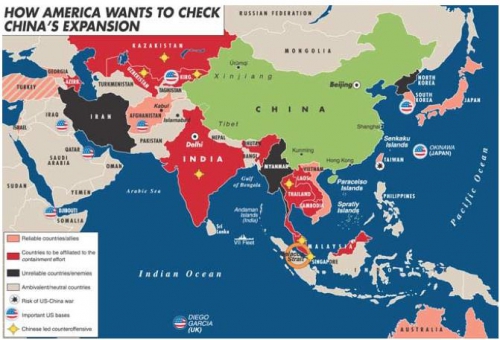vendredi, 06 mars 2015
Obama’s “Pivot to Asia” and the Military Encirclement of China

Is China The World’s New Industrial Super-Power? Obama’s “Pivot to Asia” and the Military Encirclement of China
Obama’ recent visit to India netted a trove of economic, military, and nuclear power agreements with India. The visit – and the agreements - underscored the attempt by the U.S. state to utilize its ‘pivot to Asia’ to create military and economic alliances with other Asian nations in order to encircle and isolate China.
The military wing of the ‘Asian Pivot’ is called ‘Air-Sea Battle Plan’. It involves progressively moving up to 60% of U.S. military forces into the Asian area, alongside the placement of new and advanced military equipment and new military bases and alliances with countries like the Philippines, South Korea, and Japan.
The economic wing of the pivot is the Trans-Pacific Partnership (TPP). It’s a proposed regional regulatory and investment treaty which would exclude and which currently involves negotiations between Australia, Brunei, Canada, Chile, Japan, Malaysia, Mexico, New Zealand, Peru, Singapore, the United States, and Vietnam.
This military and economic encirclement strategy confronts, however, a very large obstacle. The U.S. state may for now remain the worlds sole military super-power, based on its enormous expenditures for military, security, and online monitoring of the worlds’ people. But China has emerged in the past seven years as the worlds’ leading industrial super-power. In a shift – unprecedented historically for its speed – China has ,moved at warp speed in the past seven years to replace the U.S. as the world’s largest industrial producer. As recently as 2007, China produced a mere 62% of U.S. industrial output. But by 2011, China’s output was 120% of U.S. output, and the gap continues to grow. This displacement of the U.S. by China is the fastest shift in the balance of world industrial output in recorded economic history.
In the same period in which Chinas’ industrial production essentially doubled, US industrial output shrank by one percent,, EU industrial output declined by nine percent and Japans output shriveled by seventeen percent..
This historic shift of industrial power to China has immense consequences. To begin with, we need to recognize that real wealth is not money, stocks, bonds, or the manipulation of exotic financial instruments such as derivatives as found on Wall Street. Real wealth is the result of ability to produce goods and services which have value for human beings.
In China the hundreds of thousands of industrial workers churning out products in just one province – Guangdong – outnumber the entire industrial workforce of the U.S. An ever-increasing proportion of the worlds manufactured goods are produced: each year in China: hundreds of millions of socks to cover the worlds feet; the majority of clothing worn in the U.S. while most-often bearing U.S. brands, is China-made; computers and mobile phones such as the Apple products are primarily produced in China, as are the notebook computers sold worldwide by Chinese computer company Lenovo. The largest annual production of Chinese state-owned, joint state-private, and solely private companies. And the largest annual production of cars in any country in the world now also takes place in China. And there are the high speed Chinese-made magnetic trains which increasingly crisis-cross the country, and which are being sold and erected in varoius other countries.
The notion that China’s rise can be ‘contained’ or encircled is dubious not only because of China’s industrial prowess, but also because of the international trade it engenders.
As the Economist magazine observed: “China’s international trade in goods did indeed lead the world in 2013. Its combined imports and exports amounted to almost $4.2 trillion, exceeding America’s for the first time.” In fairness, it should be added that when international trade in services is added to trade in manufactured goods, the U.S. was still ahead. U.S. industry also retains the lead in hi-tech production methods, though that lead is being narrowed.
China’s trade relationships with other Asian nations – nations the U.S. stare is attempting to woo – constitutes a particular barrier to isolating China. The China–ASEAN Free Trade Area is a free trade area among the ten member states of the Association of Southeast Asian Nations (ASEAN) and the People’s Republic of China. Implemented in 2010, the China-Asian free trade zone reduced tarrifs or import duties on 90% of goods to zero.
Prospective participants in the U.S.-sponsored TPP are still engaged in complex negotiations. Even if successful TPP will be primarily a regulatory framework and not an actual free trade zone. By contrast, China-Asian is already the largest free trade area in terms of population, and third largest in nominal GDP, in the world. Besides China, it includes Vietnam, Thailand,, Laos, Cambodia Myanmar, Philippines, Brunei, Indonesia.and Singapore.
Chinese trade with the other member nations is growing at a healthy 10% per year; and currently stands at about 500 billion (U.S.) per year. China is furthering economic integration with its neighbors by providing financial and technical support for construction of railways linking Chinese cities with key points in neighboring countries like Vietnam and Thailand.
As the worlds’ new industrial super-power, trying to encircle or catch China is at best an arduous task. “The train.” one might say, “has already left the station.”
00:05 Publié dans Actualité, Eurasisme, Géopolitique | Lien permanent | Commentaires (0) | Tags : eurasie, asie, affaires asiatiques, états-unis, chine, encerclement de la chine, politique internationale, géopolitique, géostratégie, stratégie |  |
|  del.icio.us |
del.icio.us |  |
|  Digg |
Digg | ![]() Facebook
Facebook


